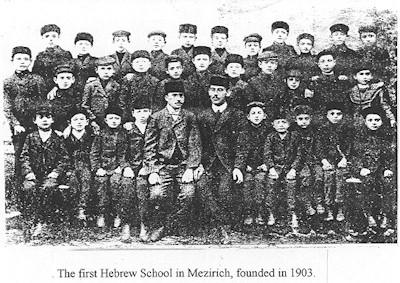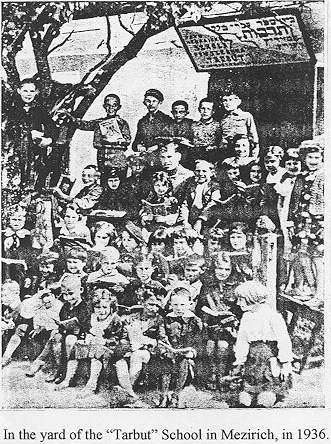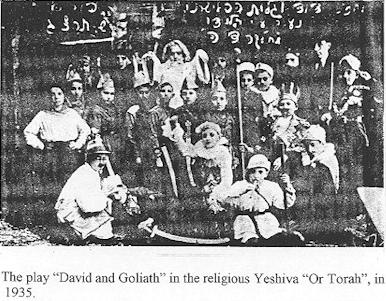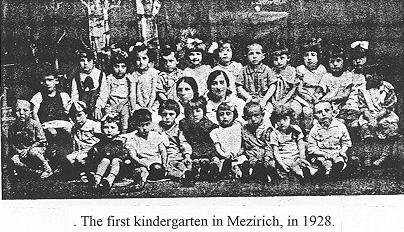Previous Page
|
Next Page
GREAT MEZIRICH
Dina Kurtz Yanai (nee Pressman) from Melzirich
In the middle of Wohlin, in a water-drawer, between two rivers, the Horin and
the Slutch, sits Mezirich (which in the Slavic language means "between the
rivers"), 45 km. from the iron rail tracks and the city of ROVNO - main
city of the region, and 20 km. from Koretz - the city bordering the U.S.S.R.,
between the two world wars. To all appearances, Mezirich was like all other
Wohlin towns, but it was set apart, distinguished as Great Mezirich. Rabbi Dov
Ber, the Great "Maggid" (Preacher), a student and follower of the
“Baal Shem Tov", chose Mezirich to be his dwelling and because of
him, the name Mezirich became famous as the city of the "Great
Maggid", the founder of Hassidism (devoutness).
The name Mezirich appears in a long list of sources, such as: "Hidden
Light" of M. Bor, Judaic Encyclopedia, Berlin, "The History of
Kaballah and Hassidism" J. Tomir 1870, the "Scriptures of the Maggid
from Mezirich", Berlin 1923. The list is too long to be included here.
Rabbi Levi Yitzchak from Berdichev, Rabbi Zussia Anopolier, who was buried in
Mezirich and his tent stood in the Mezirich Cemetery until 1941, and other
important Rabbis were all pupils of the Maggid. Mezirich is mentioned in
Russian and Ukrainian Chronicles from the 16th Century. In the 18th Century,
2000 Jews lived in Mezirich. Following the Maggid's death, the Jewish Community
declined. In 1897, 2704 Jews were registered in Mezirich. In 1932 - 3000 Jews.
This is approximately the number of Jews who lived there until the Holocaust,
perished during the Nazi period and are buried in a mass grave at a brickyard
in Nevirkov (4 km. from the town).
I am looking through the pages of the Book of Mezirich: - Yes, a Jewish town,
as the Diaspora Museum shows: A main street - (my parents' home. The pinching
in my heart is sharp as always and will remain so forever) the commercial
street. Small shops. Here's Hershel Chassia's shop -Hershel Shternshis. But who
knows people in Mezirich by their family name? There's Moshe Bobe's and Moshe
Srul's, Sheindl Naftule's and Chana Rive's. Only the Governor, Zolie Molior, is
called by his family name. So we said, Hershel Chassia's shop, where I always
bought a notebook, sometimes candles for mother, but what was there in the
shop? A half a sack of flour, a half a sack of coarse salt, a barrel of
herring, a few packages of sugar cubes, 2 Cans of kerosene and a pump, a few
bars of laundry soap, a dozen notebooks, a half-empty pencil box and many empty
shelves. That's it. On Sundays, all the shopkeepers used to gather at his shop
- to hear news. Hershel Chassia's was an intellectual Jew. At that time, he
received regularly the "Modia” ("Informer" - newspaper). On
Saturdays he read regularly the newspaper "Heint" (Today). Sometimes
he traded with a friend and looked over the "Moment", and on Sundays
he passed on his impressions. It was to him women came to read them letters
from their husbands, from America; he wrote the replies, the addresses for
everyone. Everyone knew that if Hershel Chassia's wrote the address in his
clear and round handwriting, the letter would reach everywhere. Even America it
would reach.
But on Mondays, Market Day, no one would dare to bother anyone. There were two
Market Days in Mezirich: Mondays and Thursdays. Two very important central
pillars in the merchants' livelihood.
A Summer Market Day was, of course, different from a Winter Market. Day. In the
summer, from early morning, the wagons would start arriving: it was important
to get a central place. The industrious farmer-women had gathered forest
berries and blackberries, before sunrise, to preserve the dew on them. They
filled small straw baskets or wicker baskets for sale. The forest fruits would
give off their aroma all around, and dyed its tasters' mouths black and red.
Summer. There' were those who brought dairy products: butter, yellow as wax -
from the flowers the cows eat in summer - covered with large green leaves, to
protect freshness. A triangle bag of cheese was brought (a “vorchek"
In Yiddish). The cheese was made in our area in a snow-white linen sack, thinly
woven, so that the butterfat could drip through it and the cheese would remain
in the sack: A triangle of cheese with the markings of the woven sack. And
onions were brought, a wreath of onions, and wreaths of dried mushrooms, and
fresh mushrooms, yellow, for dairy dishes, and young potatoes, radishes, green
onions, eggs, and, of course, chickens. The sellers sell their merchandise and
buy a new head kerchief, a ribbon - for the daughter to braid in her hair,
sometimes a candy for the grandchild, sewing thread, kerosene for lighting,
sometimes a piece of fabric for a shirt or a skirt. The men farmers would sell
a wagon of grain and a wagon of wood, sometimes a horse -if a son had to be
married. Sometimes they sold a wagon and bought clothes, shoes, a wheel for the
wagon, work tools. On the market there was an honourable place for the sellers
of ready-made hats ("Tandetta”). They set up stands in the square and
called out loudly to sell their merchandise. Sometimes, the farmers would end
their Market Day in a tavern and spend part of their money there . The taverns
were also the livelihood of Jews.
From the top of the hill, the Palace looks over the town. Count Stetzky's
Palace. The entire area of the town belongs to him, and he charges each one a
leasing charge, left over from the Medieval Ages.
Most of Mezirich's Jews dealt in small commerce, grain, were tradesmen. There
were three oil presses in the town, a brickyard, supplying building materials
for the surrounding area. There were seamstresses and embroiderers, tailors and
well-known hat makers in the area. There were years of relative prosperity.
There were years of depression which is when many of the townspeople emigrated
to Canada and the U.S. Mezirich had intellectuals who studied the Gemora
(religious studies), taught children - regularly taught very small children in
a "Cheder" - a room.
Mezirich Jews excelled in their piety, benevolence, charity, kindness and
devoutness, modesty, and well-being with G-d and man. In Mezirich, there
prevailed a rich traditional atmosphere and a rich national spirit. This
atmosphere, in which we grew up, sprouted the type of Wohlin Jew who was open
to people, hospitable and a good friend.
As in other communities, Mezirich was an organized community: there was an
orphans' council, brides council, money for the needy. Charity boxes helped
with small loans, at no interest, to every needy person. There was a hostel for
the poor, for passers-by. Two libraries supplied books free of charge - one from
"Tarbut", a Hebrew library, and one in the name of Ber Borochov, in
Yiddish, from “Poalei Zion" (The Workers of Zion).
There were five synagogues in Mezirich: The Great Synagogue, in the center of
town - built by the old "Paritz" (landowner) for his Jews. It was
truly a very big synagogue, taller than all the houses, and. could be seen from
afar.
The big Study House - the Maggid Dov Ber's Study House, an important learning
center in the past, was old. Every once in a while, it would be fixed but it
was strictly forbidden to rebuild it for secretive reasons. . .
The learning house of the Hassidim and Tora students, the "Trisker
Cluz"
was the new-town Synagogue (in the new town).
Previous Page
|
Next Page
This material is made available by JewishGen, Inc.
and the Yizkor Book Project for the purpose of
fulfilling our
mission of disseminating information about the Holocaust and
destroyed Jewish communities.
This material may not be copied,
sold or bartered without JewishGen, Inc.'s permission. Rights may be
reserved by the copyright holder.
JewishGen, Inc. makes no representations regarding the accuracy of
the translation. The reader may wish to refer to the original material
for verification.
JewishGen is not responsible for inaccuracies or omissions in the original work and cannot rewrite or edit the text to correct inaccuracies and/or omissions.
Our mission is to produce a translation of the original work and we cannot verify the accuracy of statements or alter facts cited.
 Mezirich, Ukraine
Mezirich, Ukraine
 Yizkor Book Project
Yizkor Book Project
 JewishGen Home Page
JewishGen Home Page
Yizkor Book Director, Lance Ackerfeld
This web page created by Lance Ackerfeld
Copyright © 1999-2026 by JewishGen, Inc.
Updated 6 July 2002 by LA








 Mezirich, Ukraine
Mezirich, Ukraine
 Yizkor Book Project
Yizkor Book Project
 JewishGen Home Page
JewishGen Home Page